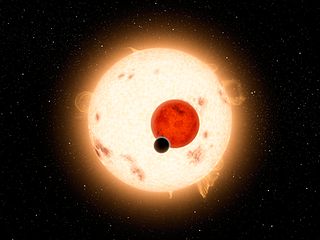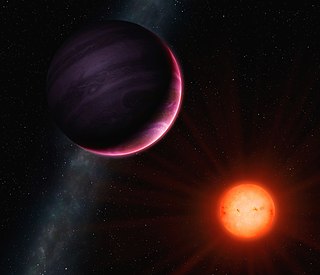Related Research Articles

Aquarius is an equatorial constellation of the zodiac, between Capricornus and Pisces. Its name is Latin for "water-carrier" or "cup-carrier", and its old astronomical symbol is (♒︎), a representation of water. Aquarius is one of the oldest of the recognized constellations along the zodiac. It was one of the 48 constellations listed by the 2nd century astronomer Ptolemy, and it remains one of the 88 modern constellations. It is found in a region often called the Sea due to its profusion of constellations with watery associations such as Cetus the whale, Pisces the fish, and Eridanus the river.

HAT-P-14b, officially named Sissi also known as WASP-27b, is an extrasolar planet located approximately 224.2 ± 0.6 parsecs (731.2 ± 2.0 ly) away in the constellation of Hercules, orbiting the 10th magnitude F-type main-sequence star HAT-P-14. This planet was discovered in 2010 by the HATNet Project using the transit method. It was independently detected by the SuperWASP project.

Kepler-16b is an exoplanet. It is a Saturn-mass planet consisting of half gas and half rock and ice, and it orbits a binary star, Kepler-16, with a period of 229 days. "[It] is the first confirmed, unambiguous example of a circumbinary planet – a planet orbiting not one, but two stars," said Josh Carter of the Center for Astrophysics | Harvard & Smithsonian, one of the discovery team.

K2-3d, also known as EPIC 201367065 d, is a confirmed exoplanet of probable mini-Neptune type orbiting the red dwarf star K2-3, and the outermost of three such planets discovered in the system. It is located 143 light-years away from Earth in the constellation of Leo. The exoplanet was found by using the transit method, in which the dimming effect that a planet causes as it crosses in front of its star is measured. It was the first planet in the Kepler "Second Light" mission to receive the letter "d" designation for a planet. Its discovery was announced in January 2015.

Kepler-1647b is a circumbinary exoplanet that orbits the binary star system Kepler-1647, 3,700 light-years (1,100 pc) from Earth in the constellation Cygnus. It was announced on June 13, 2016, in San Diego at a meeting of the American Astronomical Society. It was detected using the transit method, when it caused the dimming of the primary star, and then again of the secondary star blended with the primary star eclipse. The first transit of the planet was identified in 2012, but at the time the single event was not enough to rule out contamination, or confirm it as a planet. It was discovered by the analysis of the Kepler light-curve, which showed the planet in transit.

K2-33b is a very young super-Neptune exoplanet, orbiting the pre-main-sequence star K2-33. It was discovered by NASA's Kepler spacecraft on its "Second Light" mission. It is located about 456 light-years away from Earth in the constellation of Scorpius. The exoplanet was found by using the transit method, in which the dimming effect that a planet causes as it crosses in front of its star is measured.

NGTS-1b is a confirmed hot Jupiter-sized extrasolar planet orbiting NGTS-1, a red dwarf star about half the mass and radius of the Sun, every 2.65 days. The NGTS-1 system is about 716 light-years from Earth in the Columba constellation.

HATS-36b is a gas giant exoplanet that orbits an F-type star. Its mass is 3.216 Jupiters, it takes 4.2 days to complete one orbit of its star, and is 0.05425 AU from it. It was discovered on June 12, 2017 and was announced in 2018. Its discoverers were 23, namely Daniel Bayliss, Joel Hartman, George Zhou, Gaspar Á. Bakos, Andrew Vanderburg, J. Bento, L. Mancini, S. Ciceri, Rafael Brahm, Andres Jordán, N. Espinoza, M. Rabus, T. G. Tan, K. Penev, W. Bhatti, M. de Val-Borro, V. Suc, Z. Csubry, Th. Henning, P. Sarkis, J. Lázár, I. Papp, P. Sári.
TOI-677 b is a confirmed "warm" super-Jupiter exoplanet orbiting TOI-677, its host star, in the Ophiuchus constellation, about 466 ly (143 pc) away from Earth. The planet was discovered by NASA's Transiting Exoplanet Survey Satellite (TESS) using the transit method, in which the dimming effect that a planet causes as it crosses in front of its star is measured. Discovery of the exoplanet was announced on 13 November 2019.
K2-66b is a confirmed mega-Earth orbiting the subgiant K2-66, about 520 parsecs (1,700 ly) from Earth in the direction of Aquarius. It is an extremely hot and dense planet heavier than Neptune, but with only about half its radius.

BD+60 1417b is a confirmed exoplanet discovered in the year 2021 using the imaging method. BD+60 1417b is the only known exoplanet in the system BD+60 1417, around 45 parsecs from Earth. BD+60 1417 is a young K0 star, while BD+60 1417 b has a late-L spectral type. The planet might be the first discovery of a directly imaged exoplanet found by a citizen scientist. Discovery of exoplanets involving amateurs are usually transiting exoplanets and are rarely discovered with other methods. Another example of a non-transiting exoplanet discovery by an amateur is the microlensing exoplanet Kojima-1Lb.
HD 260655 is a relatively bright and cool M0 V red dwarf star located 33 light-years away from the Solar System in the constellation of Gemini. HD 260655 has two confirmed rocky planets, named HD 260655 b and HD 260655 c, that were discovered in 2022. Both planets were detected by the TESS mission and confirmed independently with archival and new precise radial velocity data obtained with the HIRES observatory since 1998, and the CARMENES survey instruments since 2016.

TOI-2180 b is a giant exoplanet orbiting the G-type star TOI-2180, also known as HD 238894. It was discovered with the help of the Transiting Exoplanet Survey Satellite and is currently the exoplanet with the longest orbital period TESS was able to uncover. TOI-2180 b orbits its host star every 260.16 days.
KMT-2022-BLG-0440L b is a Neptune-like exoplanet, located 11,415 light years away in the constellation of Sagittarius. It was discovered in 2023.
TOI-5678 b is a Neptune-like exoplanet, located 539 light-years away, that orbits a G-type star. It was found in 2023, located in the constellation Pegasus.
TOI-4342 is a red dwarf star in the constellation Octans located 201 light-years from Earth.
TOI-4603 b is a gas giant exoplanet orbiting HD 245134, a F-type subgiant star located 731 light-years away, in the constellation of Taurus. It orbits its host star at a distance of 0.0888 astronomical units (13,280,000 km), completing one orbit every 7 days around it. With a density of 14.1 g/cm3, it is one of the densest exoplanets known. The planet is just 4% larger than Jupiter, but is 12.9 times more massive, being located in the mass limit between planets and brown dwarfs.
TOI-3235 b is a gas giant exoplanet found 237 light-years away from Earth. It was discovered in 2023 by the transit method.
References
- 1 2 Mistry, Priyashkumar; et al. (2023). "VaTEST. II. Statistical Validation of 11 TESS-detected Exoplanets Orbiting K-type Stars". The Astronomical Journal. 166 (1): 9. arXiv: 2301.09865 . Bibcode:2023AJ....166....9M. doi: 10.3847/1538-3881/acd548 . S2CID 258685555.
- ↑ "The Extrasolar Planet Encyclopaedia — TOI-672 b". Extrasolar Planets Encyclopaedia . 1995.

